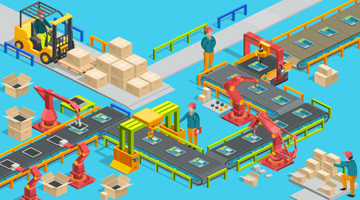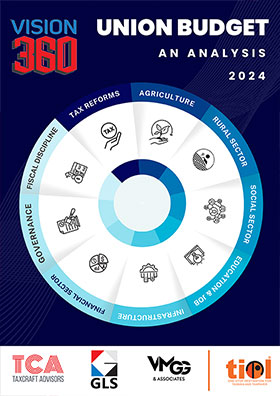Why GSTN and why not NIC?
AUGUST 21, 2015
By S Maheswaran. B.Sc., B.L.
FOR the smooth implementation of the Goods and Services Tax regime, a company in the name and style of GSTN has been formed. However there already exists an organization in the name and style of "National Informatics Centre"(NIC) doing wonders in E-governance in all parts of our country. Why did the Government opt to form a new organization called GSTN despite having one like NIC? Through this article, an attempt is made to drum support for the NIC.
GSTN is a Section 25 (not for profit) non-Government, private limited company. It was incorporated on March 28, 2013. The Company GSTN has been set up primarily to provide IT infrastructure and services tothe Central and State Governments, taxpayers and other stakeholders for implementation of the Goods and Services Tax (GST).
In fact, before the introduction of "ACES" in Central Excise and Service Tax, the "SERMON" package was developed, implemented and maintained by the NIC for computerization of the Central Board of Excise and Customs (CBEC) in the Department of Revenue. In most of the states the indirect tax system "VAT" is supported with computer infrastructure by the NIC only. Hence the NIC is familiar with indirect tax system existing both in the Central and states. To substantiate the capacity of NIC to undertake major projects involving implementation and providing IT infrastructure, let us see the salient features of NIC.
National Informatics Centre (NIC) under the Department of Electronics and Information Technology, the Ministry of Communication and Information Technology, Government of India, was established in 1976 with Headquarters based in New Delhi. NIC has various Resource Divisions at the Headquarters which specialize into different areas of IT and facilitate the Application Divisions as well as other NICCentres in providing state-of-the-art services to the Govt.
NIC has emerged as a "prime builder" of e-Government / e-Governance applications upto the grassroots level as well as a promoter of digital opportunities for sustainable development. NIC, through its ICT Network, "NICNET", has institutional linkages with all the Ministries /Departments of the Central Government, 35 State Governments/ Union Territories, and about 625 District administrations of India. NIC has been instrumental in steering e-Government/e-Governance applications in government ministries/departments at the Centre, States, Districts and Blocks, facilitating improvement in government services, wider transparency, promoting decentralized planning and management, resulting in better efficiency and accountability to the people of India.
"Informatics-led-development" programme of the government has been spearheaded by NIC to derive competitive advantage by implementing ICT applications in social & public administration. The following major activities are being undertaken:
++ Setting up of ICT Infrastructure
++ Implementation of National and State Level e-Governance Projects
++ Products and Services
++ Consultancy to the government departments
++ Research and Development
++ Capacity Building
During the last three decades, NIC has implemented many "network centric" application software for Programme implementation in various ministries and departments, using state-of-the-technology software tools. During 1980s and early part of 1990s, the policy thrust was on creating "Management Information System (MIS)" and "Decision Support System (DSS)" for development, planning and responsive administration in governments which led to the genesis of present day "e-Governance" / "e-Government". "Bridging the Digital Divide", "Social and Financial Inclusion through ICT" and "Reaching- the-Unreached", which concepts were tried and made operational in the late nineties. NIC has vast expertise and experience in the design, development and operationalisation of various e-Government projects in the areas of Public Administration and Governance like Agriculture & Food, Animal Husbandry, Fisheries, Forestry & Environment, Industry, Health, Education, Budget and Treasury, Fiscal Resources, Transport, Water Resources, Court Management, Rural Development, Land Records and Property registration, Culture & Tourism, Import & Exports facilitation, Social Welfare Services, Micro-level Planning, etc. With increasing awareness leading to demand and availability of ICT infrastructure with better capacities and programme framework, the governance space in the country witnessed a new round of projects and products, covering the entire spectrum of e-Governance including G2C, G2B&G2G with emphasis on service delivery.
NIC provides Nationwide Common ICT Infrastructure to support e-Governance services to the citizen, Products and Solutions designed to address e-Governance Initiatives, Major e-Governance Projects, State/UT Informatics Support and district level services rendered.
NIC has set up state-of-the-art ICT infrastructure consisting of National and state Data Centres to manage the information systems and websites of Central Ministries/Departments, Disaster Recovery Centres, Network Operations facility to manage heterogeneous networks spread across Bhawans, States and Districts, Certifying Authority, Video-Conferencing and capacity building across the country. National Knowledge Network (NKN) has been set up to connect institutions/organizations carrying out research and development, Higher Education and Governance with speed of the order of multi Gigabits per second. Further, State Government secretariats are connected to the Central Government by very high-speed links on Optical Fibre Cable (OFC). Districts are connected to respective State capitals through leased lines.
Various initiatives like Government eProcurementSystem(GePNIC), Office Management Software (eOffice), Hospital Management System (eHospital), Government Financial Accounting Information System (eLekha), etc. have been taken up which are replicable in various Government organizations.
As NIC is supporting a majority of the mission mode e-Governance projects, the chapter on National e-Governance Projects lists the details of these projects namely National Land Records Modernization Programme (NLRMP), Transport and National Registry, Treasury Computerisation, VAT , MG-NREGA, India-Portal, e-Courts, Postal Life Insurance, etc. NIC also lays framework and designs systems for online monitoring of almost all central government schemes like Integrated Watershed Management (IWMP), IAY, SGSY, NSAP, BRGF, Schedule Tribes and other Traditional Forest Dwellers Act etc.
ICT support is also being provided in the States / UTs by NIC. Citizen centric services are also being rendered electronically at the district level, such as Income Certificate, Caste Certificate, and Residence Certificate etc. along with other services like Scholarship portals, permits, passes, licenses to name a few.
The organizational set up of NIC encompasses its Headquarters at New Delhi, State Units in all the 28 State capitals and 7 Union Territory Headquarters and District centres in almost all The Districts of India. The Organization employs a large pool of efficient technical manpower. At the NIC Headquarters, a large number of Application Divisions exist which provide total Informatics support to the Ministries and Departments of the Central Government. NIC Computer Cells are located in almost all the Ministry Bhawans of the Central Government and Apex Offices including the Prime Minister's Office, the RashtrapatiBhawan and the Parliament House.
However, the newly formed GSTN has recently called for tender for Supply of Internet lease line, for IT facility Management System and for supply of MFD and desktop printers. Though the formation of a new organization like GSTN for providing IT infrastructure for the smooth transformation and implementation of the indirect tax system in our country to a new one like GST is a welcome one, there still exists the question "why GSTN and why not NIC?"
It is felt that the government should have preferred services of "NIC" for implementation of GST, if necessary after strengthening the same, instead a forming a new one like GSTN.
(The author is Superintendent of Central Excise, Chennai and the views expressed are strictly personal.)
|
(DISCLAIMER : The views expressed are strictly of the author and Taxindiaonline.com doesn't necessarily subscribe to the same. Taxindiaonline.com Pvt. Ltd. is not responsible or liable for any loss or damage caused to anyone due to any interpretation, error, omission in the articles being hosted on the sites)
|















